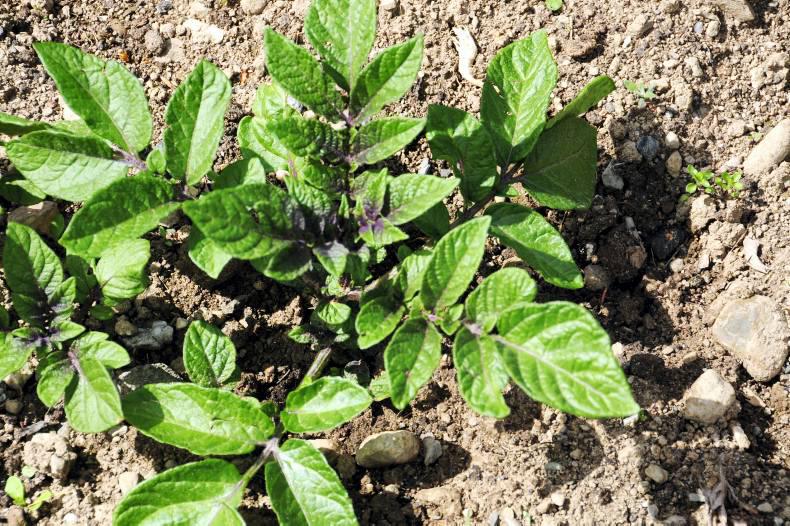While it is a bit early for ordinary lavender to come into flower, French lavender has begun already and it extends the lavender season nicely.
This plant is also sometimes called Spanish lavender and it comes from coastal parts of most of the Mediterranean countries. French lavender is a different species from common lavender, notably because it carries relatively large bracts at the top of the flower spike.
These long bracts are an additional signal to pollinators. The spike of flowers is shorter, darker in colour and the tiny flowers that make up the spike are smaller and dark coloured.
It has quite a different look to the common lavender with fewer flower spikes, which are broader and bolt upright, while the common lavender plant gives a more rounded outline.
French lavender is very effective in a flower border with its upright stems, dark short flower spikes and bright purple bracts at the top of the spikes.
It is small-growing and there are various named forms, such as ‘Provencal’ with several pink purple bracts; ‘Regal Splendour’ with pale wine-red wings; ‘Purple Wings’, rich purple, and ‘Tiara’, which has greenish white wings over a purple flower head. ‘Lilac Wings’ has pale purple-pink tops and ‘Victory’ is similar with longer wings.
While French lavender is gaining popularity, it is not as hardy in cold inland areas as the common lavender and needs the right soil conditions.
Common lavender is also native to the Mediterranean region and has been grown in northern Europe for many centuries, for its scent.
Most of the kinds sold are selections that are able to cope with less sunshine and less heat that the Mediterranean countries can offer.
Lavender is well adapted to the dry, exposed and sun-baked hills where it grows wild – the leaves of this small shrub are grey-green, linear in shape and have the edges rolled back underneath to reduce moisture loss. The foliage and stiff stems can take constant buffeting of wind without damage.
The flowers are carried on slender stems, strong although quite light, and the flowers themselves are carried in a dense spike at the top.
Opening from rounded buds, the flowers may be coloured dark purple to light pink. Each little floret opens in its turn over a period of time, closing when it has been visited by bees or other pollinating insects. The flowering period stretches over several weeks in summer.
The common lavender makes a small, dense and rounded bush to about 1m tall and a bit more wide in vigorous plants.
Mostly, selected varieties are grown, including ‘Hidcote’, which is a good purple-blue colour and fairly compact, not the same plant as ‘Hidcote Giant’ which is much bigger, too big for most gardens. ‘Munstead’ is tight in growth habit and ‘Twickel Purple’ is neat, and a good rich purple. ‘Loddon Pink’ is small with pale pink flowers.
Lavender of all kinds does best in relatively dry, well-drained soil, in full sunshine. The plant also prefers limy soil, but will grow perfectly well in acidic soil too. When grown in a gravel bed, which suits it very well, it is not unusual to see self-sown seedlings, a sure sign that a plant is growing in the right conditions.
Damp soil shortens a lavender plant’s life, but it can last for decades in the right place, though tending to become somewhat scrawny. To keep the plant neat and extend its life, clip over the top immediately after flowering, taking off the tips of the shoots and the spent flower stems. CL
>> This week
Fruit, vegetables and herbs
Thin out vegetables that have reached suitable size. It is still too early to plant out tender vegetables such as sweetcorn and runner beans, except in very mild areas. Sow maincrop vegetables such as carrots, broccoli and peas. Sow seeds of cabbage and cauliflower for autumn and winter to plant out.
Flowers
Slugs and snails were not very active in the cool weather, but a few warm days can see them cause severe damage to susceptible plants like hostas and ligularia. Bedding plants can be planted out in the coming two weeks or so. Do not be in a hurry with bedding plants unless you are in a mild area.
Lawn
Feed a lawn that is not growing well or is pale in colour. Carry out any lawn repairs while the soil is still moist in case of a dry spell. Trim the edges around flower beds or borders, before the grass gets long. It is getting a bit late for lawn mosskiller as it will blacken the lawn at a time when it is growing well.
Trees, shrubs and roses
Spray against rose blackspot using a rose spray, if it was a problem last year with susceptible varieties. Prune spring shrubs as they go out of flower, if they are too big or of bad shape. Forsythia, flowering currant, kerria and spring spirea might need pruning if the bushes are growing too large for their space.
Greenhouse and house plants
House plants can be re-potted now, using half-and-half peat compost and ordinary garden soil. Plant out tomatoes, chilli peppers, cucumbers and sweet peppers as soon as space becomes available in the greenhouse. Feed greenhouse plants strongly now to get good growth before mid-summer.
Potatoes delayed
With such a wet and cold spring, there was a lot of delay in planting potatoes. Even when planted, the shoots were slow to grow and emerge, as the soil temperatures were low for extended periods.
There was a good spell of several days of dry weather in March but it was still cold. But potatoes are warm-weather plants and respond very quickly to an improvement in temperatures.
Homegrown crops will quickly catch up when the summer weather arrives and a reduction in crop because of earlier delay will not be significant, though early varieties will be delayed.






SHARING OPTIONS